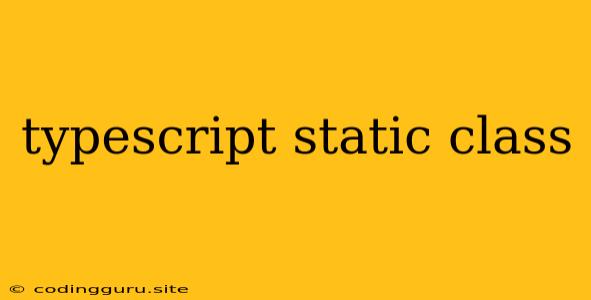Understanding Static Classes in TypeScript
TypeScript, a superset of JavaScript, brings powerful features to the table, including the ability to define static classes. But what exactly are static classes, and how do they differ from regular classes? Let's delve into this concept and explore its benefits and use cases.
The Essence of Static Classes
In essence, static classes in TypeScript are classes that primarily focus on static members. These members are accessible directly on the class itself, without the need to create an instance of that class. In contrast, regular classes in TypeScript typically have both static and instance members.
Here's a fundamental difference:
- Regular classes: You need to create an object (an instance) of the class to access its members.
- Static classes: You access members directly through the class name, without creating an instance.
Why Use Static Classes?
Static classes serve as excellent tools for encapsulating functionality that doesn't require an instance of a class. They can house utility methods, constants, and other functions that are shared across your codebase.
Here are some key reasons to consider using static classes:
- Organization and Reusability: Group related functionality into a single, well-defined unit.
- Namespace Management: Prevent naming conflicts by organizing related functions and variables under a specific class.
- Singletons: Implement a singleton pattern, ensuring a single instance of a class is available across your application.
Building a Static Class
Let's construct a simple example to illustrate how to create a static class in TypeScript:
class MathUtils {
static add(a: number, b: number): number {
return a + b;
}
static subtract(a: number, b: number): number {
return a - b;
}
}
const result = MathUtils.add(5, 3); // Accessing static method directly on the class
console.log(result); // Output: 8
In this snippet, MathUtils is our static class. Notice that the add and subtract methods are declared using the static keyword. We don't need to create a MathUtils object to call these methods; we invoke them directly on the class itself.
Best Practices and Considerations
When designing your static classes, keep these points in mind for optimal code organization and maintainability:
- Purpose: Ensure your static class serves a clear and focused purpose within your project.
- Modularity: Keep your static classes relatively small and focused to improve their manageability.
- Naming Conventions: Use descriptive names for your static classes and their members.
- Testing: Test your static classes thoroughly to ensure their correctness.
Static Classes in Action: A Practical Scenario
Let's consider a practical example of using a static class in a TypeScript application:
Imagine you're building a web application with a feature to handle user authentication. You might utilize a static class to manage authentication logic, providing methods for signing in, logging out, and retrieving user information.
class AuthService {
static isLoggedIn(): boolean {
// Logic to check user authentication status
// ...
}
static signIn(credentials: UserCredentials): Promise {
// Logic to handle user sign-in
// ...
}
static signOut(): Promise {
// Logic to handle user sign-out
// ...
}
}
This static class encapsulates all the authentication-related functionality, making it easily accessible throughout your codebase.
Conclusion
Static classes provide a powerful means to organize and encapsulate shared functionality in TypeScript. They promote code reusability, reduce redundancy, and enhance code clarity. By leveraging static classes effectively, you can write more maintainable and well-structured TypeScript code.
